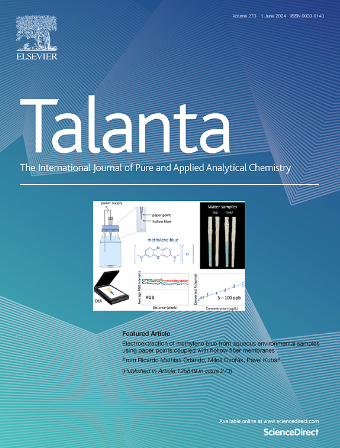Flexible sensor based on molecular imprinting for simultaneous in situ detection of indole-3-acetic acid and salicylic acid in plants
IF 6.1
1区 化学
Q1 CHEMISTRY, ANALYTICAL
引用次数: 0
Abstract
In plants, indole-3-acetic acid (IAA) and salicylic acid (SA) are critical for defense responses, making their simultaneous detection essential for understanding regulation mechanisms. This study developed a flexible laser-induced graphene (LIG) sensor enhanced with MXene nanosheets for improved conductivity and catalytic activity. A molecularly imprinted polymer (MIP) film, using chitosan (CS) as the monomer and IAA/SA as templates, was fabricated on the electrode surface. The MIP/MXene/LIG/PDMS sensor, with excellent flexibility for curved leaf surfaces, detected IAA and SA simultaneously in ranges of 5–100 μM and 5–1000 μM, with detection limits of 0.921 μM and 1.677 μM. Applied in situ to strawberry leaves under salt stress, this sensor offers promising applications in precision agriculture.

基于分子印迹的柔性传感器同时原位检测植物中吲哚-3-乙酸和水杨酸
在植物中,吲哚-3-乙酸(IAA)和水杨酸(SA)对防御反应至关重要,因此同时检测它们对了解调节机制至关重要。本研究开发了一种柔性激光诱导石墨烯(LIG)传感器,该传感器由MXene纳米片增强,以提高导电性和催化活性。以壳聚糖(CS)为单体,IAA/SA为模板,在电极表面制备了分子印迹聚合物(MIP)膜。MIP/MXene/LIG/PDMS传感器在5 ~ 100 μM和5 ~ 1000 μM范围内同时检测IAA和SA,检出限分别为0.921 μM和1.677 μM。该传感器在盐胁迫下对草莓叶片进行原位检测,在精准农业中具有广阔的应用前景。
本文章由计算机程序翻译,如有差异,请以英文原文为准。
求助全文
约1分钟内获得全文
求助全文
来源期刊

Talanta
化学-分析化学
CiteScore
12.30
自引率
4.90%
发文量
861
审稿时长
29 days
期刊介绍:
Talanta provides a forum for the publication of original research papers, short communications, and critical reviews in all branches of pure and applied analytical chemistry. Papers are evaluated based on established guidelines, including the fundamental nature of the study, scientific novelty, substantial improvement or advantage over existing technology or methods, and demonstrated analytical applicability. Original research papers on fundamental studies, and on novel sensor and instrumentation developments, are encouraged. Novel or improved applications in areas such as clinical and biological chemistry, environmental analysis, geochemistry, materials science and engineering, and analytical platforms for omics development are welcome.
Analytical performance of methods should be determined, including interference and matrix effects, and methods should be validated by comparison with a standard method, or analysis of a certified reference material. Simple spiking recoveries may not be sufficient. The developed method should especially comprise information on selectivity, sensitivity, detection limits, accuracy, and reliability. However, applying official validation or robustness studies to a routine method or technique does not necessarily constitute novelty. Proper statistical treatment of the data should be provided. Relevant literature should be cited, including related publications by the authors, and authors should discuss how their proposed methodology compares with previously reported methods.
 求助内容:
求助内容: 应助结果提醒方式:
应助结果提醒方式:


